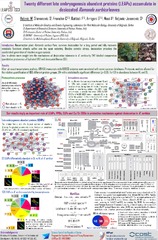Приказ основних података о документу
Twenty different late embryogenesis abundant proteins (LEAPs) accumulate in desiccated Ramonda serbica leaves
| dc.creator | Vidović, Marija | |
| dc.creator | Stevanović, Strahinja | |
| dc.creator | Franchin, Cinzia | |
| dc.creator | Battisti, Ilaria | |
| dc.creator | Arrigoni, Giorgio | |
| dc.creator | Masi, Antonio | |
| dc.creator | Veljović Jovanović, Sonja | |
| dc.date.accessioned | 2021-05-31T10:26:47Z | |
| dc.date.available | 2021-04-01 | |
| dc.date.issued | 2021 | |
| dc.identifier.uri | https://inppo.org/inppo2020/ | |
| dc.identifier.uri | https://cherry.chem.bg.ac.rs/handle/123456789/4424 | |
| dc.description.abstract | Resurrection plant Ramonda serbica Panc. survives desiccation for a long period and fully recovers metabolic functions already within one day upon watering [1]. Besides osmotic stress, desiccation provokes the accelerated generation of reactive oxygen species. The aim of our study was obtaining more insight into the mechanisms of desiccation tolerance in R. serbica by TMT labelled comparative quantitative proteomics of hydrated (HL) and desiccated leaves (DL). After de novo transcriptome analysis, 189456 transcripts with 189003 unigenes were annotated with seven common databases. Proteomic analysis allowed for the relative quantification of 895 different protein groups, 321 with a statistically significant difference in abundance between FL and DL. Among them, 25% referred to chloroplast and almost the same percentage were associated with desiccation and oxidative stress. Almost all differentially abundant proteins related to photosynthetic processes were down-regulated in DL, while those required for protein translation were more abundant in HL. Within differentially abundant proteins involved in antioxidative defence, the levels of enzymes involved in ascorbate-glutathione cycle, peroxiredoxins, Fe and Mn superoxide dismutase (SOD) were all reduced in DL, while germin-like proteins, three Cu/Zn SOD isoforms and polyphenol oxidases were more abundant in DL compared with HL. The protein family with the highest number of members showing the greatest accumulation upon desiccation comprised twenty different late embryogenesis abundant proteins (LEAPs), similarly as found by differential transcriptomic analysis. Taken together, our results imply a key role of LEAPs and Cu/Zn SOD in protective mechanism against desiccation in R. serbica, that may have significant implications on drought-related studies of crops grown in arid areas. This work was supported by the Science Fund of the Republic of Serbia (PROMIS project LEAPSyn-SCI, grant number 6039663). M.V. wishes to acknowledge the support of COST Action BM1405 for approving STSM in Padua during 2017 and 2018. | sr |
| dc.language.iso | en | sr |
| dc.publisher | International Plant Proteomics Organization | sr |
| dc.relation | info:eu-repo/grantAgreement/ScienceFundRS/Promis/6039663/RS// | sr |
| dc.relation | COST Action BM1405 | sr |
| dc.relation.isversionof | https://cherry.chem.bg.ac.rs/handle/123456789/4842 | |
| dc.rights | openAccess | sr |
| dc.rights.uri | https://creativecommons.org/licenses/by-nc/4.0/ | |
| dc.source | The Fourth Conference of the International Plant Proteomics Organization | sr |
| dc.subject | Resurrection plant | sr |
| dc.subject | TMT-labeled quantitative proteomics | |
| dc.subject | de novo transcriptome | |
| dc.subject | superoxide dismutase | |
| dc.title | Twenty different late embryogenesis abundant proteins (LEAPs) accumulate in desiccated Ramonda serbica leaves | sr |
| dc.type | conferenceObject | sr |
| dc.rights.license | BY-NC | sr |
| dcterms.abstract | Видовиц, Марија; Стевановиц, Страхиња; Францхин, Цинзиа; Баттисти, Илариа; AРРИГОНИ, ГИОРГИО; Маси, Aнтонио; Вељовиц Јовановиц, Соња; | |
| dc.description.other | Related to conference abstract: [https://cherry.chem.bg.ac.rs/handle/123456789/4842] | |
| dc.type.version | publishedVersion | sr |
| dc.identifier.fulltext | https://cherry.chem.bg.ac.rs/bitstream/id/26977/bitstream_26977.pdf | |
| dc.identifier.rcub | https://hdl.handle.net/21.15107/rcub_cherry_4424 |


